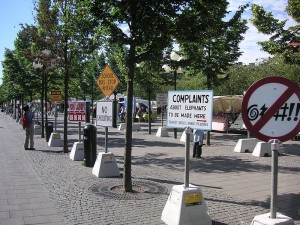Your Guide to Driving Abroad for the First Time
Vacationing in a foreign country can be quite an adventure, packed with new experiences and memories to last for decades. Sometimes even the transportation offers an adrenaline rush! Americans driving abroad for the first time may find the experience a bit more challenging than anticipated. Armed with a bit of information about international driving, however, even cautious tourists will find themselves readily adjusting to driving in other parts of the world. Let’s begin with a review of American driving conventions.
In the United States, traffic moves on the right-hand side of the road, and drivers sit on the left. Speed limits are generally lower than they are in other parts of the world, as are the legal blood alcohol limits. Speed is calculated in miles per hour (MPH), and children under age four must be restrained in a child safety seat in the rear of the car. All drivers must carry a valid driving license; those still taking driving lessons may use a permit, but must be accompanied by a licensed adult driver.
Americans who wish to drive while abroad will need an international driving permit; these are excellent and affordable pieces of photo identification that can be extremely useful for quickly identifying oneself to foreign law enforcement officials, so it’s wise to obtain one even if you don’t plan on actually driving. The permits cost about $20. It’s also prudent to research the driving regulations in your destination country and bring a printed copy for handy reference while abroad.
The driving culture in many areas of the world differs significantly from that of the United States. This is particularly true in Latin America, where cars (rental or not) are often in serious disrepair and have no functioning headlights or turn signals. Major speeding, left turns from the right-hand lane and oblivious pedestrians can make Latin American roads very stressful for American drivers. If you must drive in Latin America, do it during the daytime only, and be on the lookout for giant potholes and other unrepaired road hazards.
Driving in India presents similar challenges. Urban roads are densely packed with vehicles, pedestrians, cyclists and livestock – particularly cows, which are sacred in Hindu culture and must be given the right of way at all times. Some cities have laws that require drivers to wear helmets, although these are often poorly enforced. Eye protection is highly recommended due to the high volume of insects. International driving permits are essential, and tourists caught driving without one may face stiff fines; the police are particularly strict about this.
Americans driving in Europe often have difficulty finding a rental car with an automatic transmission. Tourists uncomfortable driving a stick-shift car should make a rental reservation as far in advance as possible. Filling stations and rental depots are often closed on Sundays. Many credit cards offer collision insurance that’s better than the insurance offered by rental agencies. This insurance rarely covers driving in Ireland. Car theft is a huge problem in Italy, so be prepared to pay a theft insurance premium of about $7 per day.
In many European countries vehicles travel on the left side of the road and sit on the right side of the car, which may be disconcerting for Americans. Practicing in a rural or low-traffic area is highly recommended prior to driving in big cities. If you have an accident, you’ll be asked to sign a European Accident Report, which contains details of the crash but doesn’t blame any party; don’t sign any other documents for any reason.
‘This guest post was brought to you by PassSmart.com; the quick and easy way to find a driving instructor in the UK






